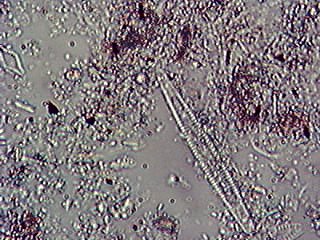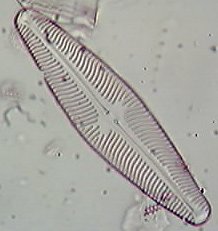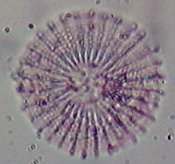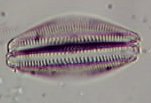
1 |

2 |
|
by Bill Ells, UK |
In a recent issue of 'Balsam Post' the newsletter of the 'Postal Microscopical Society', Ernie Ives a regular contributor mentioned that he uses Silvo™ metal polish to sharpen his microtome knives. Some years ago I examined a smear of metal polish under the microscope and found it contained many diatoms. Naturally I wondered if these polishes still contained diatoms, so I got out the polish, we currently use Goddard's™, and put a smear on a slide. Sure enough there were plenty of diatoms, see photo' No.1. Although I could see them plainly enough through the microscope I could not get a decent photo' using my webcam.
I decided to try and clean some up. I put a little of the polish in a test tube and added distilled water, shook it up, let it settle, then siphoned off most of the water. I repeated this four or five times. I then put a little on a cover glass and heated it over a spirit lamp, when it was dry I put a small drop of Naphrax on a slide, placed the cover glass diatom side down on the Naphrax and heated the slide over the flame. On examination I found some nice clean diatoms, many of them unbroken. See photo's nos. 2 - 5. These were taken using a Nikon x40 plan fluorite N.A. 0.75 and a x4 projection eyepiece. Although my webcam does not give very high definition, most of the unbroken diatoms are recognisable, Epithemia argus and Amphora veneta can be seen.
Of course I have no idea where the diatomite used in the polishes came from, also I do not have sufficient knowledge of diatoms to know if they are of freshwater or marine origin. I have named those above with the aid of 'A guide to the morphology of the diatom frustule' by E.Y. Haworth and the late H.G. Barber and published by the Freshwater Biological Association, which suggest they are from freshwater unless they are also found in marine environments.
Diatomite used to be mined in Kentmere in the English Lake District. It is still sucked up from the bed of Lake Mývatn in Iceland, it is pumped to the nearby factory and dried using steam from a geothermal power station. The resulting powder is used as a filter for wine and beer among other things. This is described in a 'Visitors Guide to Iceland'. Not mentioned is silver polish. I believe the biggest marine deposits mined commercially are in California, U.S.A.
All comments to the author Bill Ells are welcomed.
Images

1
2

3
4
5
Please report any Web problems or
offer general comments to the
Micscape
Editor,
via the contact on current Micscape
Index.
Micscape is the on-line monthly magazine
of the Microscopy UK web
site at Microscopy-UK